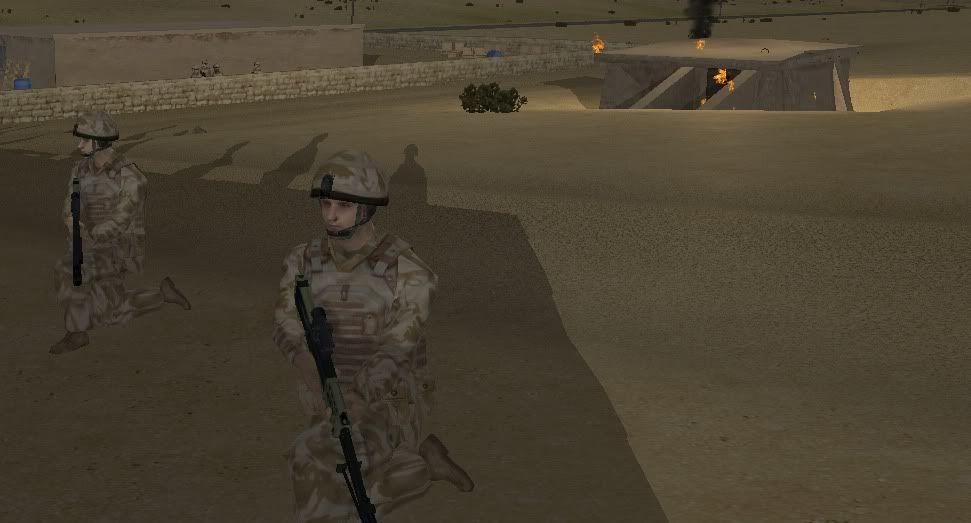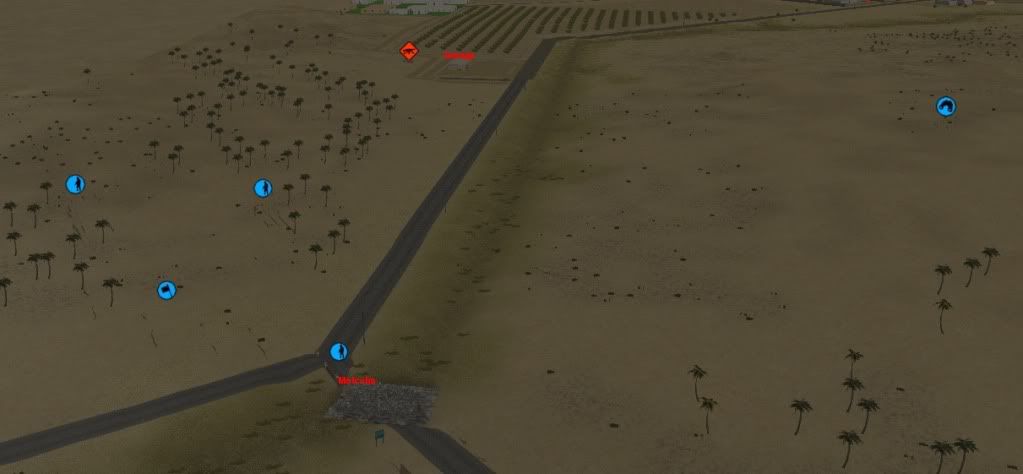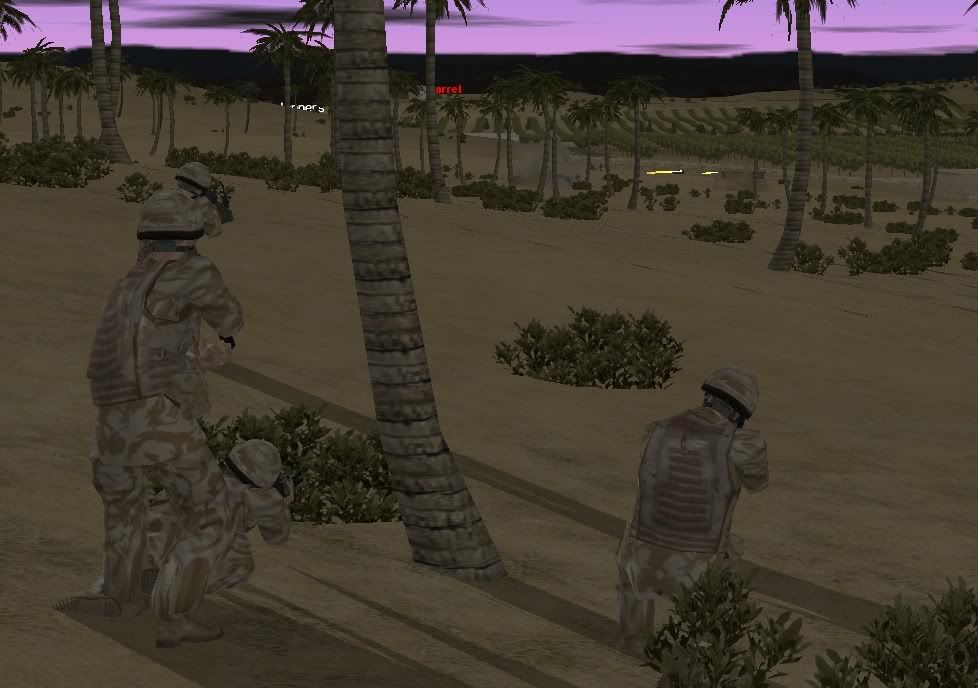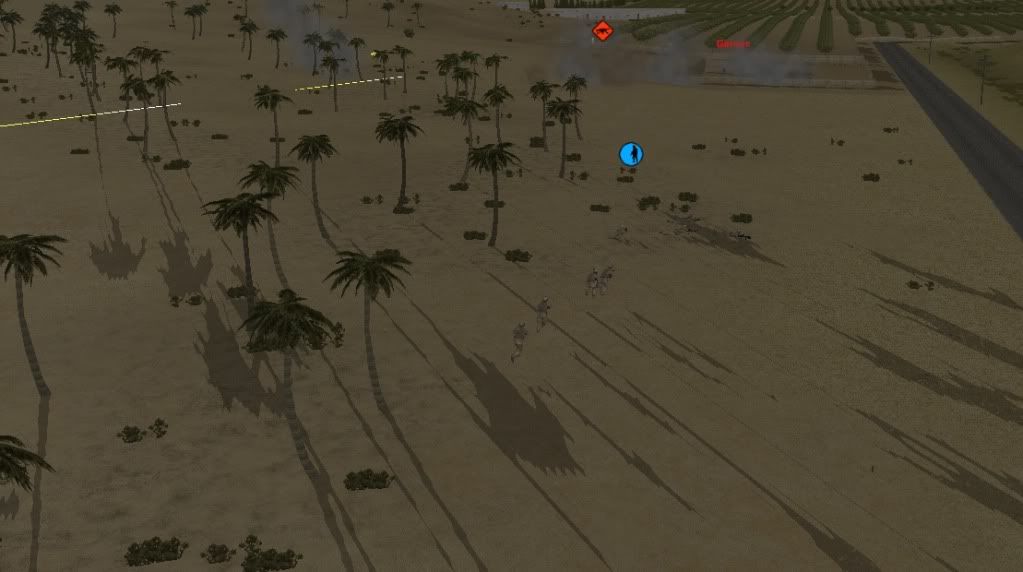
hcrof
-
Posts
1,100 -
Joined
-
Last visited
Posts posted by hcrof
-
-
I have just posted the same thing in the "Assaulting Fierce and Agile" thread. Is there any chance I could add this stuff to the community strategy guide?
It would need to be edited and have a couple of diagrams added but it is very useful information.
-
I havn't had a look at this thread for a long time - it is really good stuff. Chainsaw, can I add it to the community strategy guide?
-
Ah yes, Syrian artillery. Almost worth a couple of pages on its own
 . You can get it to work but is requires planning and control of the battle. If your opponent has the initiative you are pretty screwed
. You can get it to work but is requires planning and control of the battle. If your opponent has the initiative you are pretty screwedThe lack of target reference points really doesn't help either.
-
Look at the 'deploy' button on the UI, if it is depressed it is deployed (or deploying). Or just zoom in to see if they have the tripod set up!
-
Well unless the Russians have done some reorganisation at platoon level since 1988 (and I don't think they have) the squad has 8 men - 1 sergeant, 2 RPK gunners, 1 RPG gunner and 4 riflemen, one of whom acts as an assistent RPG gunner. The Mechanised squads are tranported in a BMP-1/2 carrier which has 2 crew members when the squad dismounts (the sergeant controls the carrier with flags and hand signals/mobile Phone AFAIK).
In combat the platoon is commanded by a single liutenant or experienced sergeant and 1 squad in the platoon will also normally carry a SVD sniper rifle. The company will also add 1 MANPAD gunner and either the first sergeant, welfare officer or technical officer to each platoon.
In addition to the above mentioned equipment the squads will carry as much additional stuff they can get their hands on. 2 or more single shot RPG-18/22/26/27 launchers are common as well as RPO launchers. In fact, when in Chechnia the soldiers seemed to prefer the single shot launchers to the RPG's (IMO). As well as that, squads can also swap an RPK with a PKM.
Basically, when going into combat a Russian squad will fill its carrier with as much firepower as they can stuff inside - regulations seem to go out of the window!
-
As above - I am doing this mainly to improve my own skill at CMSF, I am getting my butt kicked right now in a couple of PBEM's

Please add your own tactics/AARs and correct any mistakes I have made, even if you can't do that I would love some more screenshots to illustrate the guide when it comes out.
-
Well after a focused look at an infantry platoon assault it is time to pull back a bit and look at infantry in general. Remember, I would love people to give their own opinions, AARs, pictures and tactics so please contribute!
The Infantry
Infantry have always been and will continue to be central players in warfare. Infantry are the only part of the military that can take and hold ground and when fighting in built up areas they are by far the most important component of a force.
Infantry are however very vulnerable to just about any threat on the modern battlefield and so they almost always work as a combined team with the other branches of the military. Tanks can help punch holes in enemy lines, artillery can suppress and destroy positions and air assets can remove threats as they appear.
The Attack
- Take out enemy weapons first – It might sound obvious but make sure you take out as many of the enemy positions as you can before the infantry assault. They will have enough to worry about during the attack so make their lives easier for them and soften up the enemy first. This will increase the speed of the attack and result in fewer casualties.
- Suppression is Key! – Position machine guns, supporting vehicles or even infantry squads into positions with good fields of fire before the attack. Just before the attack starts, open fire and make sure that anything that could contain troops has bullets going into it. Make sure you have a few guns with no specific targets to engage targets of opportunity though.
- Blind the enemy – Taking out spotters and deploying smoke will isolate the position being attacked and prevent the enemy supporting the objective. Smoke can also be useful to screen your advancing infantry until the last minute but make sure that you are able to keep suppressing positions.
- Keep a reserve – Eventually an attack can lose momentum, perhaps the unit has taken casualties or has run out of ammunition. An infantry reserve can reinforce success and keep the attack moving by throwing fresh troops into the fray.
The Defence
- Avoid obvious positions – Defending troops almost always have a disadvantage in firepower. Even if the defence is very strong, it must be a surprise to the attacker for it to be effective. If the enemy guesses where you men are they will suppress them from a distance with heavy weapons and your troops will be unable to fight. Artillery is the biggest killer here – enough artillery will destroy any position eventually.
- Create interlocking fields of fire – If a position is taken out it can create a gap in the defences that the enemy will exploit. If units can support each other than the defences are stronger as these gaps will not appear so quickly.
- Don’t bunch your troops up – Bunching your troops up will lead to defeat against a competent opponent. Once the enemy has found out where you are you will be hit by artillery. Bunched up infantry are very vulnerable to indirect fire and casualties will be high.
- Consider a mobile defence – Although it cannot be used in every situation, a mobile defence will allow you to seize the initiative from your opponent. A unit can fire from a position and displace before effective fire is returned. The attacking force will take casualties and not be able to ‘pin you down’ so heavy weapons and artillery become less effective. This tactic works best in close terrain with lots of covered routes to safety.
The Western and Syrian approaches on how to use infantry are very different. Tactics that are successful with Western forces will fail when they are attempted with Syrian troops. Below is a summary outlining their differences.
Western Forces
Western infantry are incredibly well trained and equipped. This allows them a lot of tactical flexibility and firepower which should pull them through almost any situation the Syrians can throw at them. They can put out effective fire out to 300-400m and their body armour will help protect them against return fire.
Most importantly, their training and cohesion will allow them to push the fight to the enemy even in the direst of circumstances. Where others will be suppressed and broken, they will stand their ground and even attack! This is not to say they are invincible. Unsupported they can be fixed and then ground down by heavy weapons.
Syrian Forces
Syrian infantry is wedded to their fighting vehicles. They cannot operate effectively without them beacuse they need the extra firepower and flexibility. A Syrian infantry squad has a shorter effective range on their assault rifles and worse quality light machine guns integrated into the unit. In addition they do not have the cohesion of the western forces so will quickly break under fire.
Their vehicles are essential because they will transport the infantry safely across the battlefield to a position where the infantry can launch their final assault then support the attack with their guns. This has to be part of a combined arms attack as the vehicles themselves are vulnerable. Because of this, artillery, smoke and tank support are even more important than when using western forces. Any assault will fail without them.
Also, it is best to use larger formations than western forces. A platoon is a unit and must be used together. A platoon however still has to be used as part of a company - they don't have the independence to operate alone. As a rule of thumb, think of a Syrian platoon as a western squad and a Syrian company as a western platoon.
The one advantage the Syrian infantry has over the western ones is the RPG. This weapon is both flexible and powerful, capable of adding huge amounts of organic firepower to a squad in both its anti tank and anti personnel role.
- Take out enemy weapons first – It might sound obvious but make sure you take out as many of the enemy positions as you can before the infantry assault. They will have enough to worry about during the attack so make their lives easier for them and soften up the enemy first. This will increase the speed of the attack and result in fewer casualties.
-
The guy back left is a US soldier holding an AK with a grenade launcher. I assume it was better than his M4 so he picked it up from a freindly Syrian (Afghan) casualty
-
Yes, If the enemy ever put their head up they can start chucking grenades at the assaulting section. That is obviously very bad so the support element gives supressive fire thoughout.
Currently I stop my assault element about 3 squares away from the objective and open fire with everything I have before leapfrogging into grenade range and finishing the job. I then stop the platoon shooting and move the assault element through the objective to make sure everyone is dead and to find cover from which I can defend myself/give cover fire to the trailing elements.
-
I think that any attack that can be written up will be a 'special case' just because every battle is different. The above illustration is of a platoon assault so that implies that I decided to close with the enemy (because I judged them to be of low enough strength for the platoon to deal with on its own).
You could just keep area firing a position but you would use a lot of small arms ammo (in short supply in this mission). Equally, if they do manage to bug out they might move to a more dangerous position. By flanking a position they lose much of their defensive advantage and by closing them you are able to gain a decisive victory.
What I could have done, especially if the enemy was infantry in trenches would be to pin them with fire before using mortars or GMG's to destroy the position. Eventually I would still have to close with the position to check that it is clear of enemy but hopefully I would be advancing on a load of dead bodies.
-
Well I could try to do it but I think it would be best for a member of the community who knows more about these things than I to write something up. It doesn't have to be fancy, just text which would take 15 minutes for someone who knows what they are talking about.
We could then add pictures/diagrams etc later.
My expertise is not western tactics so I couldn't really write down anything with any certainty. Could someone offer their knowledge?
-
zwobot - You are correct, if the supporting section takes fire and becomes suppressed an obvious option would be to use the reserve section to put fire on that position too. Another option would be to use the 51mm mortar to gain fire superiority. A few rounds of that will cause enemy casulties and suppress them effectively. You can then keep them suppressed with fire from your supporting section and keep the reserve uncommited. A third option would be to use smoke grenades/mortar to disengage and call down artillery or air to destroy the position.
I can't remember the exact times but I used 2-3 mins to prepare, get into positions and request smoke. I used 4-5 mins to suppress the enemy and assault the position and another 1-2 mins reorganising afterwards. It might seem that I am taking my time but by not rushing it you can deal with suprises much better.
About 'Abort Conditions', I really should have them but I am a bit arrogent when playing as Blue
 . I am prepared to delay an assault but I probably won't pull back once I have comitted. The problem is that in CMSF you are under a very tight time timit compared with the real world and also things like smoke which is needed to break contact is in very short supply. If I had 8 hours to develop the battle, comms with Brigade HQ who could allocate me more assets and a massive bucketload of patience I would play it more realisticly (and probably take fewer casualties as a result)
. I am prepared to delay an assault but I probably won't pull back once I have comitted. The problem is that in CMSF you are under a very tight time timit compared with the real world and also things like smoke which is needed to break contact is in very short supply. If I had 8 hours to develop the battle, comms with Brigade HQ who could allocate me more assets and a massive bucketload of patience I would play it more realisticly (and probably take fewer casualties as a result) -
If the AI doesn't think it is dangerous because it doesn't see the AT team it will not execute the contact drill. A VBIED is a different unit to a taxi so when it is identified (within a couple of hundred meters to qualify as a threat) the platoon can engage it.
After the target is destroyed the armoured platoon just carries on with its previous fire arc etc after a couple of seconds. As each turn is only a minute long, that is all you need.
-
I think you are mistaken when it comes to both tolerance and equal rights.
Call be an optimist but I know several gay people who are free to express themselves with nothing more than a bit of banter about thier sexuality. Ethnic minorities are accepted by pretty much everyone I have met and those who disagree keep thier mouths shut. Racists seem to be dying out compared to 50 years ago with only a couple of ill educated idiots who genuinely hate non-white people. This anti muslim histeria is just a blip that has been blown out of proportion by the media IMO.
The biggest success of course has been the emancipation of women with the feminist movement now struggling to maintain its relevence in a world where they have pretty much achieved the goals they set out to achieve.
So yeah, I'm young and naive

-
Its basically right, yeah, the platoon would split down into the assault section, the support section (who will suppress the enemy) and a reserve. Platoon HQ will be located somewhere between the Support and Reserve. The usual advance to contact formation will either be a "one up, two down" triangle or a "two up, one down" triangle, depending on the threat.
Once contact is made the lead team will become the section that suppresses the enemy while a hasty plan is made. The reserve teams will then either be allocated as extra firepower to suppress the enemy or as assault teams to move in for the kill, so to speak.
It's all very flexible, really, so just use the terrain and your fire support to your advantage and your attack should go fine.
Another guide about how to deal with multiple in-depth positions might be needed though
 They're the real kick in the pants - when you discover another enemy platoon is dug in behind the one you just barely managed to clear out...
They're the real kick in the pants - when you discover another enemy platoon is dug in behind the one you just barely managed to clear out...Thanks for the confirmation - my sole military experience was cadets back at school and we did it without a platoon HQ, just a retired WO1 moving between sections on his own

I wasn't moving in a triangle because I was just crossing that river but I suppose I could just pretend I was 2 up, 1 back for clarity and simplicity. I don't think a guide to crossing an obstacle is really needed is it?
In terms of multiple in depth positions, could you give a clue as to the military solution? I don't know the textbook answer so I would just play it by ear. The other question is how a western mechanised platoon would attack an objective. I can do a guide for the Syrians assuming they do it Soviet style (nice and simple) but I have no idea as to the details of a British or American attack!
-
That is why I said a dangerous enemy! Only tanks, VBIED's and IFV's would be included in that (probably depending on Range/angle to front armour) as they are the only ones that can do damage to the armoured platoon.
-
There has been a certain amount of talk about contact drills that the Tac AI could do when it encounters the enemy.
I don't know what is feasable given time constraints but how is this for a simple one:
When a tank/IFV spots an enemy, the information is currently shared with the rest of the platoon. If the enemy is dangerous, like an enemy tank, all the guns of the platoon should swing round to look for the threat no matter what the current orders are (assuming that they have LOS to the enemy) . So if the platoon is ambushed from the side, the tanks don't sit passively as the platoon gets picked off one by one.
Im sure infantry contact drills would be popular too but probably be harder to implement.
-
Its disgusting really what they did to him, especially with what he accomplished. The guy probably deserved a knighthood and yet they castrated him.
I'm glad that I grew up in a more tolerent society where there are equal rights for all.
-
Taken from the AAR described in the community strategy guide in the strategy and tactics forum. http://www.battlefront.com/community/showthread.php?p=1156267#post1156267
Please contribute!

A British infantry platoon form an all round defence after taking an enemy position.
-
Bump.
Shall I keep putting stuff up here? Or shall I just work on the guide myself and publish it when I have finished?
-
The above is taken from an ongoing PBEM game. I was given the opportunity to conduct a textbook platoon assault on my opponent so I decided to record it as a mini AAR. It only took half an hour but hopefully it illustrate the 'right'* way to attack with infantry.
If anyone spots a moment they think might be able to use to teach someone tactics please submit it to the guide!
*Could any British Infantrymen confirm that I am correct here? I think that is how it works!
-
The Infantry Platoon Assault
The following example would be described as a 'textbook' assault on a fixed position. It gives you the principles of what an infantry platoon is expected to do but situations in the real world are rarely as ideal as the one shown. This is not to say that you should ignore the textbook answers though. Knowing the basics will help you in real battles as you can adapt this assault to lots of different situations. This example was taken from a PBEM game against a human opponent.
The Situation

While crossing an obstacle, the platoon spots a machine gun bunker covering the road, blocking the path of the infantry. The mortar fire controller providing overwatch is informed and because the platoon appears to outnumber the enemy by more than 3-1, the lieutenant decides to conduct a hasty assault.
- Tip – When attacking, a force ratio of 3-1 can be considered enough to achieve victory with little cost. This rises to 6-1 in urban areas. In CM however these forces are difficult to achieve because it would make for an unbalanced battle. Try to concentrate your attacks to achieve local odds of 3-1 or greater at the decisive point.
The Plan

2 section will provide suppressive fire from the hill while 1 section moves parallel to the road in a flanking manoeuvre, covered by smoke from 81mm mortars. This move will be protected from any other enemy forces because it is using dead ground in a valley. 3 section and the HQ group will form a reserve to deal with any contingencies.
1 section will then assault the position with grenades and automatic fire before the platoon moves to an all round defence at the objective.
- Tip – Dead ground is a dip in the ground which cannot be observed by the enemy. Finding it can be crucial to a battle but remember, a canny opponent will use mines, artillery and ambushes in these areas because moving into it can be predictable.

Supression

The Flanking Manoeuvre
The result
The platoon moves into position while the mortars are requested and guided onto target. 2 section spreads out and opens fire on the target as the smoke rounds begin to fall. As soon as the smoke screen begins to form, 1 section begins to advance in bounds (advance command) and arrives at the garage wall, out of the firing arc of the bunker.
As bayonets are fixed however, a lucky LASM hit from 2 section hits an ammo crate inside the bunker, killing everyone inside and sending a plume of smoke into the air. 1 section then moves through the objective to prevent counter attacks and the platoon forms an all round defence around the bunker. It is too dangerous to check the enemy bodies but the platoon takes a few minutes to check and redistribute ammo and check for friendly casualties before continuing onwards along their original route.

Due to effective suppression of the position and the fact that it had no support, the assault was achieved with no casualties. Suppression is key to any assault as it stops the enemy shooting at the advancing infantry who will quickly take casualties if they receive effective fire.
Smoke is a good way of removing support from a position so you can concentrate your fire on fewer locations and protect your advancing troops. It allows you to chop the enemy into smaller pieces which can be defeated in turn but remember – you are only given a limited amount!
-
Hunt is useful when approaching hull down positions, just in case of any surprises!
-

CMx1 games
in Combat Mission Shock Force 1
Posted
I agree with Other Means, it felt like a board game when I went back and sooo ugly! (even with mods)
I am looking forward to Normany (or rather the eastern front game ) for when I want to go back to WW2
) for when I want to go back to WW2